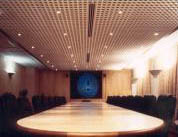Advice from three successful CIOs
 In the past 15 years, “enterprise IT” has been transformed from an accounting support function to the driver-enabler for innovation and value creation. By no means has this been a smooth transformation, as businesses in all industries are besieged by globalization, new competitors and rampant commoditization. At many companies, executives around the boardroom table have had mixed feelings about IT in the face of huge expenditures and uncertain ROIs. In the past 15 years, “enterprise IT” has been transformed from an accounting support function to the driver-enabler for innovation and value creation. By no means has this been a smooth transformation, as businesses in all industries are besieged by globalization, new competitors and rampant commoditization. At many companies, executives around the boardroom table have had mixed feelings about IT in the face of huge expenditures and uncertain ROIs.
At the Executives’ Club of Chicago High Technology Conference last week, Michael S. Carlin of Hospira, Richard Shellito of State Farm Insurance and Randy G. Burdick of OfficeMax shared their advice on keeping IT relevant in the boardroom. After their prepared remarks, Winifred A. Gillen of Capgemini moderated the panel during a Q&A session.
[…]
Peter Sondergaard opened the analyst firm’s vaunted annual Symposium/ITxpo this week by admonishing CIOs to prepare for a consumer shift that will reverse the current state in which business and government control customer and constituent relationships. As reported by eWeek, Gartner’s head of global research didn’t pull any punches: businesses will have to earn the right to justify premium offerings by empowering consumers:
 “The impact of consumerization is the most important trend impacting IT in the next 10 years,” Sondergaard remarked. “There will be a shift in culture reflecting the dominance of the ‘digital natives.’ Consumer technology will be integrated into (the) home, home office, in transit or recreational areas, and users will initiate interactions from all of these settings.” “The impact of consumerization is the most important trend impacting IT in the next 10 years,” Sondergaard remarked. “There will be a shift in culture reflecting the dominance of the ‘digital natives.’ Consumer technology will be integrated into (the) home, home office, in transit or recreational areas, and users will initiate interactions from all of these settings.”
[…]
If you have started to get the feeling that something new and big is afoot in the consumer Web world, no, you’re not having flashbacks to 1997
 Web 2.0 is a new phenomenon that is beginning to realign the balance of power between producers/providers of products/services and customers because it enables customers to self-organize and wield unprecedented influence in the market. “Web 2.0” refers to a group of (usually) free user-friendly Web applications like blogs, wikis, integrated video/phone services and social networking sites (more below) that enable individuals to connect, collaborate and concatenate with unprecedented ease. E-Commerce (doesn’t it sound quaint now?) first enabled consumers to gain a new level of information about products and services and, as adoption proceeded, to buy over the Web. That was “Web 1.0” and it was still largely one-way communication because information flowed from the Web to customers. “Web 2.0” is focused on letting individuals self-organize, interact, collaborate and be equal players in what aficionados call “the conversation” of the Web. Web 2.0 is a new phenomenon that is beginning to realign the balance of power between producers/providers of products/services and customers because it enables customers to self-organize and wield unprecedented influence in the market. “Web 2.0” refers to a group of (usually) free user-friendly Web applications like blogs, wikis, integrated video/phone services and social networking sites (more below) that enable individuals to connect, collaborate and concatenate with unprecedented ease. E-Commerce (doesn’t it sound quaint now?) first enabled consumers to gain a new level of information about products and services and, as adoption proceeded, to buy over the Web. That was “Web 1.0” and it was still largely one-way communication because information flowed from the Web to customers. “Web 2.0” is focused on letting individuals self-organize, interact, collaborate and be equal players in what aficionados call “the conversation” of the Web.
Before you B2B-focused readers yawn and turn the page, consider that this will turn […]
Part of the IDC Outsourcing Forum Midwest Report
 The Williams Companies is a Fortune 200 energy company that currently distributes 12% of all the natural gas consumed in the United States and is a major employer in Tulsa, Oklahoma. Marcia MacLeod, Vice President of Business Process Outsourcing, and Karen Caldwell, Director for Energy & Utilities at IBM, explained how the company pulled a Houdini in the early 2000s, using outsourcing to survive a near-death experience in which its stock dropped from $48 to less than one dollar. This case reflected outsourcing’s potential in dramatic turnaround situations while confronting some outmoded stereotypes about its impact on local employment. The Williams Companies is a Fortune 200 energy company that currently distributes 12% of all the natural gas consumed in the United States and is a major employer in Tulsa, Oklahoma. Marcia MacLeod, Vice President of Business Process Outsourcing, and Karen Caldwell, Director for Energy & Utilities at IBM, explained how the company pulled a Houdini in the early 2000s, using outsourcing to survive a near-death experience in which its stock dropped from $48 to less than one dollar. This case reflected outsourcing’s potential in dramatic turnaround situations while confronting some outmoded stereotypes about its impact on local employment.
[…]
|
|
 In the past 15 years, “enterprise IT” has been transformed from an accounting support function to the driver-enabler for innovation and value creation. By no means has this been a smooth transformation, as businesses in all industries are besieged by globalization, new competitors and rampant commoditization. At many companies, executives around the boardroom table have had mixed feelings about IT in the face of huge expenditures and uncertain ROIs.
In the past 15 years, “enterprise IT” has been transformed from an accounting support function to the driver-enabler for innovation and value creation. By no means has this been a smooth transformation, as businesses in all industries are besieged by globalization, new competitors and rampant commoditization. At many companies, executives around the boardroom table have had mixed feelings about IT in the face of huge expenditures and uncertain ROIs.
 “The impact of consumerization is the most important trend impacting IT in the next 10 years,” Sondergaard remarked. “There will be a shift in culture reflecting the dominance of the ‘digital natives.’ Consumer technology will be integrated into (the) home, home office, in transit or recreational areas, and users will initiate interactions from all of these settings.”
“The impact of consumerization is the most important trend impacting IT in the next 10 years,” Sondergaard remarked. “There will be a shift in culture reflecting the dominance of the ‘digital natives.’ Consumer technology will be integrated into (the) home, home office, in transit or recreational areas, and users will initiate interactions from all of these settings.” Web 2.0 is a new phenomenon that is beginning to realign the balance of power between producers/providers of products/services and customers because it enables customers to self-organize and wield unprecedented influence in the market. “Web 2.0” refers to a group of (usually) free user-friendly Web applications like blogs, wikis, integrated video/phone services and social networking sites (more below) that enable individuals to connect, collaborate and concatenate with unprecedented ease. E-Commerce (doesn’t it sound quaint now?) first enabled consumers to gain a new level of information about products and services and, as adoption proceeded, to buy over the Web. That was “Web 1.0” and it was still largely one-way communication because information flowed from the Web to customers. “Web 2.0” is focused on letting individuals self-organize, interact, collaborate and be equal players in what aficionados call “the conversation” of the Web.
Web 2.0 is a new phenomenon that is beginning to realign the balance of power between producers/providers of products/services and customers because it enables customers to self-organize and wield unprecedented influence in the market. “Web 2.0” refers to a group of (usually) free user-friendly Web applications like blogs, wikis, integrated video/phone services and social networking sites (more below) that enable individuals to connect, collaborate and concatenate with unprecedented ease. E-Commerce (doesn’t it sound quaint now?) first enabled consumers to gain a new level of information about products and services and, as adoption proceeded, to buy over the Web. That was “Web 1.0” and it was still largely one-way communication because information flowed from the Web to customers. “Web 2.0” is focused on letting individuals self-organize, interact, collaborate and be equal players in what aficionados call “the conversation” of the Web. The Williams Companies is a Fortune 200 energy company that currently distributes 12% of all the natural gas consumed in the United States and is a major employer in Tulsa, Oklahoma. Marcia MacLeod, Vice President of Business Process Outsourcing, and Karen Caldwell, Director for Energy & Utilities at IBM, explained how the company pulled a Houdini in the early 2000s, using outsourcing to survive a near-death experience in which its stock dropped from $48 to less than one dollar. This case reflected outsourcing’s potential in dramatic turnaround situations while confronting some outmoded stereotypes about its impact on local employment.
The Williams Companies is a Fortune 200 energy company that currently distributes 12% of all the natural gas consumed in the United States and is a major employer in Tulsa, Oklahoma. Marcia MacLeod, Vice President of Business Process Outsourcing, and Karen Caldwell, Director for Energy & Utilities at IBM, explained how the company pulled a Houdini in the early 2000s, using outsourcing to survive a near-death experience in which its stock dropped from $48 to less than one dollar. This case reflected outsourcing’s potential in dramatic turnaround situations while confronting some outmoded stereotypes about its impact on local employment.